Toy Rotation & Toy Storage
Mar 4th, 2014 by Sarah
Today, I wanted to talk a little about toy rotation & storage … and share what’s been working for us.
After Haley had her first birthday, followed just a few months later by Christmas, I knew it was time to do something different about the toy situation. I know we have far fewer toys than a lot of families, but they seemed to all be multiplying and taking over our house … and, while I love her toys, love buying her new ones, and want her to have plenty of fun things to keep her stimulated and engaged, I didn’t like how the piles were growing in the family room or how Haley’s room was totally cluttered and overflowing.
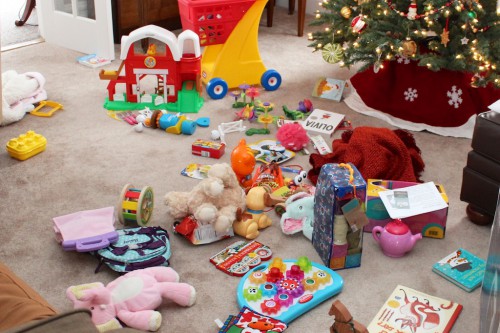
About half of the toys Haley got for Christmas.
When I was growing up, the solution to this problem was a basement play room with lots of shelves for storing all of the toys – and it worked well for us. But when I started to think about making a playroom for Haley in our house, it just didn’t seem like the right fit. For one, she’s only 17 months old, so I still like to have her in earshot all the time and keep a close eye on her while she plays, which would mean I would need to be in the playroom with her all the time. And, second, we don’t really have a room in our house that would be a clear choice for converting to a playroom. So, I started looking online for creative storage solutions for toys, hoping to find something ingenious that would help make a mountain of toys seem more manageable …and there are tons of great ideas like that (baskets, shelves, other organizing tools, etc.), but what really appealed to me was implementing a system for toy rotation.
As I started reading about toy rotation, I found a lot of really great articles that provided good background information on why it’s such a great idea … and I’d definitely encourage you to check those out (since I’m clearly not an expert on this topic). Here’s a link to one that I thought summed it up really nicely. It became really clear that there were a lot of benefits besides just managing the toy clutter.
When I started to work through how we would implement a toy rotation system in our house, I found a couple of other posts (here and here) that were really useful in detailing how to practically make this work. After reading about what had worked for others, I decided to give it a try, but with these tweaks:
- I wanted to have multiple areas in the house with toys so that Haley could play wherever we spent time together rather than having just one set of toys out in one designated play area.
- I didn’t want to pack away most of her toys in plastic storage bins and then find a place to keep the bins of toys that were currently out of rotation. Storage space is limited enough as it is.
- I wanted to be able to change up which toys were grouped together for each rotation so she could have different experiences playing with them.
So, based on that, we started with the process below, which we’ve stuck with for the last few months – and I’m sold. I’m sure there’s probably a more efficient way to do this, but (for now) this is our system:
- I gather up all of the toys in the house (from all of Haley’s play areas) and put them all in one central location (we use her room).
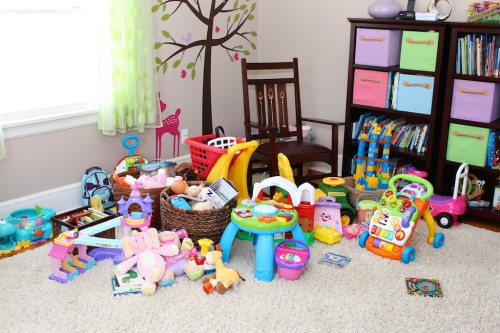
All of our toys gathered in one spot.
- I sort through all of the toys, grouping like things together. Roughly, the categories I use for this sorting are:
- Stuffed Animals
- Pretend Play toys (dolls & accessories, tea set, dress up, etc.)
- Thinking toys (puzzles, blocks, shape sorters, etc.)
- Movement toys (ride-on toys, pull toys, balls, etc.)
- Electronic learning toys (usually Vtech or Leap Frog stuff)
- BooksA couple of the websites I read had a whole long list of categories to use for the sorting step and it all just seemed a little overwhelming to me. Maybe as she gets older and has a wider range of toys it will make sense to add a few more categories to the list, but this seems to catch everything for now. Also, some of her toys could easily fit into multiple of the above categories, and I don’t worry too much about that – I just put it in one of the piles and keep going.Here are a couple of our piles of toys, sorted by category:
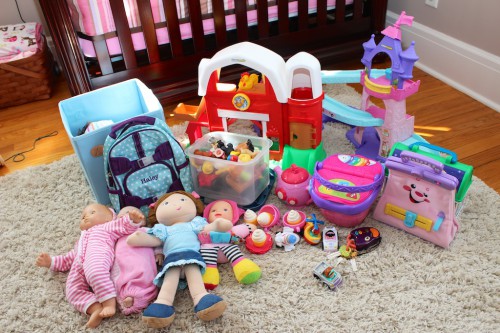
Pretend toys.
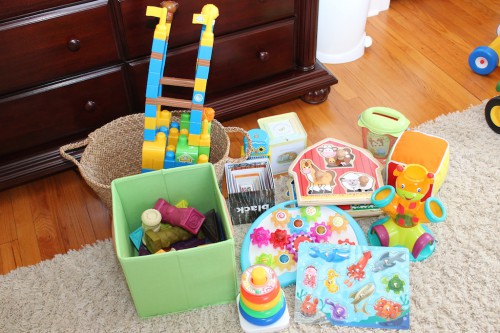
Thinking Toys
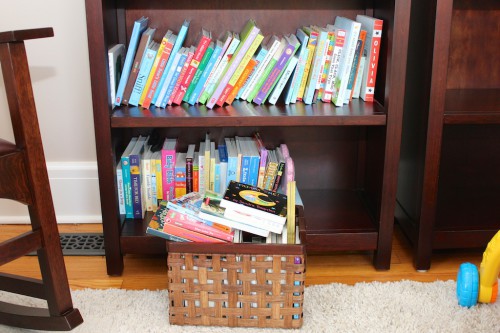
Books
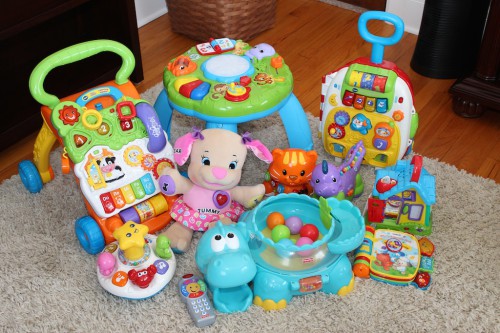
Electronic learning toys.
- Once everything is more or less sorted, I start making groups of toys to keep in different rooms throughout the house. For each group, I try to get one or two items from each of the categories along with a few books. For the way we live in our house, I make groups of toys to keep in the family room, kitchen, the master bedroom, Haley’s playpen, and a group to leave sitting out in Haley’s room. I include more toys for the areas where we have more space, so my final groups aren’t all the same size. Here are some of the toy groupings we came up with when we rotated today:
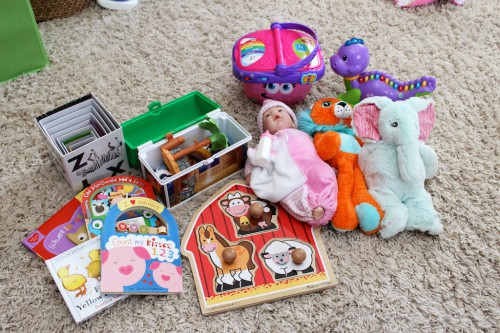
Toys for the kitchen.
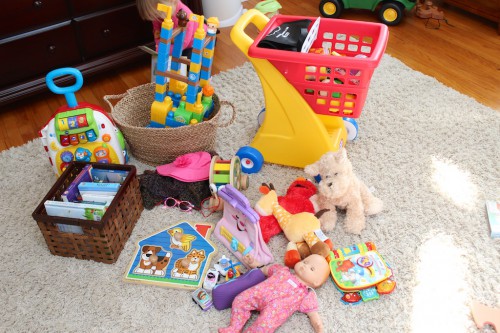
Toys for the family room.
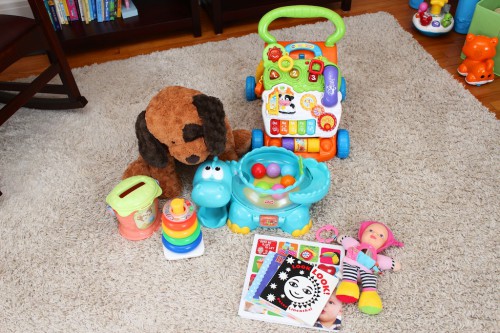
Toys for the master bedroom.
- For any items that are “left over” at the end of each toy sorting/rotation session, I tuck them away in Haley’s room. Stuffed animals and dolls go in a big basket, books go on the shelf in her room, other miscellaneous toys go in canvas bins on her shelves.
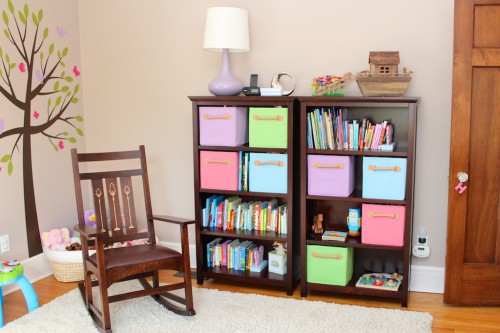
Anything that’s leftover gets tucked away in the bins on Haley’s shelves.
- I carry the baskets/groups of toys through the house and deposit them where they will live until the next toy rotation. Here are some pictures from today’s rotation:
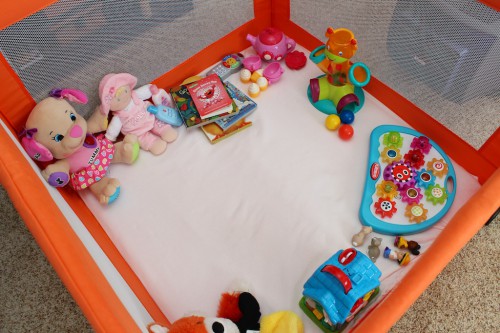
Freshly rotated toys in Haley’s playpen.
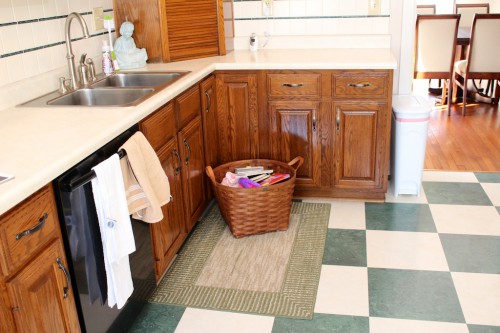
The kitchen toy basket.
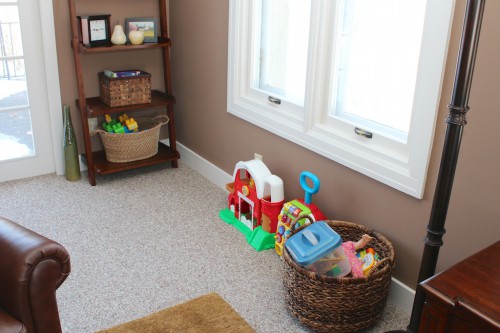
Toys in the family room. Books & blocks are in baskets on the shelves, her shopping cart is tucked into a corner on the opposite side of the room and everything else is lined up along this wall.
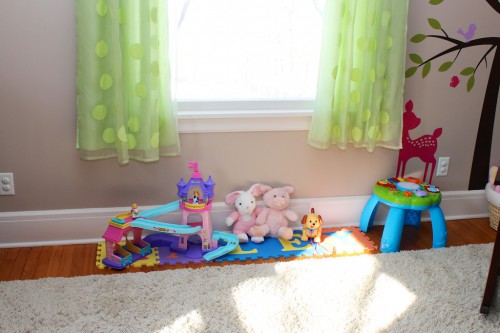
Along with the items on her lower shelves, we leave a few other toys out in Haley’s room.
The entire process takes less than an hour and I do it whenever I notice her starting to get bored with the current arrangement (usually about once a month).
We’ve been rotating toys like this for about 6 months, but got a lot more organized about it after the holidays and we’ve noticed so many benefits. We were successful in the primary goal of avoiding mountains of toys in a few rooms of the house, replacing them instead with a small number of toys in a bunch of different spots where we spend time. This has worked out really well – I can tolerate a smaller selection of toys better, Haley is more engaged with the toys when there aren’t so many available to play with, and we have toys for her in all of the rooms where we spend most of our time, which is an added bonus. It’s also pretty easy to tell when it’s time to rotate the toys. She gets bored and just rolls around in the playpen during independent playtime rather than playing with the toys. And she stops being interested in whatever is in her toy baskets in the kitchen and family room. So, then we rotate and she gets so excited to see all of her toys in new spots throughout the house – it’s like Christmas all over again. Actually rotating the toys might seem like a pain, but the payoff is totally worth it.
Having said all of that, there are things that don’t always work out perfectly every time – and that’s ok. Haley almost always has a favorite toy or two (usually her baby doll is one of them) that gets carried around the house with her and doesn’t stay in whatever room it started out in. This is fine, but after a few weeks with a lot of different favorite toys, we can be a little long on toys in one room and a little short in another. And sometimes I just totally mess up a grouping of toys in one room and she’s isn’t interested in any of the toys in that basket. It doesn’t always make a lot of sense, but adding another one or two toys (a few more Little People, an accessory for the baby doll, etc.) can make the whole basket fun again.
So, in a nutshell, that’s how we’ve been managing Haley’s toy collection and it’s been working well so far. I’m sure our method will evolve as she gets older, acquires more toys, and the variety of toys in the house start to change. The next step is for me to warm up to the idea of actually parting with the toys she’s outgrown. Of course, that would be like admitting that my baby is growing up and I’m still definitely in denial on that topic – so, that’ll have to be a project for another day … another day in the very distant future!
Filed Under: Cleaning and Organizing




